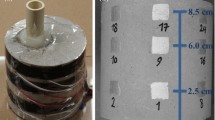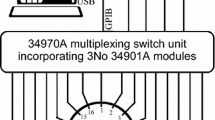Abstract
The development of visualizing tools to monitor unsaturated moisture flow in cement-based materials is of great importance, as most degradation processes in cement-based materials are connected to and take place in the presence moisture. This paper investigates the ability of electrical capacitance tomography (ECT) to image two-dimensional (2D) unsaturated moisture flow in cement-based materials. In ECT, the electrical permittivity distribution within an object is reconstructed based on measured capacitances between electrodes attached on the object’s surface. In a series of experiments, mortar specimens with and without discrete cracks were imaged with ECT during a 2D moisture ingress. The results show that ECT is able to monitor the evolution of the moisture flow, and to approximate the shape and position of the moisture front. These findings indicate that ECT is a viable method for monitoring and visualizing 2D unsaturated moisture flow in cement-based materials in the presence and absence of discrete cracks.






Similar content being viewed by others
References
Ghasemzadeh F, Pour-Ghaz M (2014) Effect of damage on moisture transport in concrete. J Mater Civ Eng 27(9):04014,242
Castro J, Bentz D, Weiss J (2011) Effect of sample conditioning on the water absorption of concrete. Cement Concr Compos 33(8):805–813
Akhavan A, Rajabipour F et al (2012) Quantifying the effects of crack width, tortuosity, and roughness on water permeability of cracked mortars. Cem Concr Res 42(2):313–320
Hall C, Hoff W (2011) Water Transport in Brick, Stone and Concrete, 2nd edn. Taylor & Francis, park
Monteiro PJM, Mehta PK (2006) Concrete microstructure, properties and materials, 3rd edn. McGraw-Hill, New York
Neville A (1996) Properties of concrete, 4th edn. Wiley, Hoboken
McCarter WJ, Emerson M, Ezirim H (1995) Properties of concrete in the cover zone: developments in monitoring techniques. Mag Concr Res 47(172):243–251
McCarter WJ (1996) Monitoring the influence of water and ionic ingress on cover-zone concrete subjected to repeated absorption. Cem Concr Aggreg 18(1):55–63
McCarter WJ, Ezirim H, Emerson M (1996) Properties of concrete in the cover zone: water penetration, sorptivity and ionic ingress. Mag Concr Res 48(176):149–156
McCarter WJ, Watson D (1997) Wetting and drying of cover-zone concrete. Proc ICE Struct Build 122(2):227–236
McCarter WJ, Chrisp TM, Starrs G, Adamson A, Owens E, Basheer PAM, Nanukuttan SV, Srinivasan S, Holmes N (2011) Developments in performance monitoring of concrete exposed to extreme environments. J Infrastruct Syst 18(3):167–175
McCarter WJ, Chrisp M (2000) Monitoring water and ionic penetration into cover-zone concrete. ACI Mater J 97(6):668–674
Rajabipour F, Weiss J, Shane JD, Mason TO, Shah SP (2005) Procedure to interpret electrical conductivity measurements in cover concrete during rewetting. J Mater Civ Eng 17(5):586–594
Buettner M, Ramirez A, Daily W (1996a) Electrical resistance tomography for imaging the spatial distribution of moisture in pavement sections. In: Structural materials technology an NDT Conference, San Diego, California
Buettner M, Ramirez A, Daily W (1996b) Electrical resistance tomography for imaging concrete structures. In: Structural materials technology an NDT Conference, San Diego, California
Hallaji M, Seppänen A, Pour-Ghaz M (2015) Electrical resistance tomography to monitor unsaturated moisture flow in cementitious materials. Cem Concr Res 69:10–18
du Plooy R, Villain G, Palma Lopes S, Ihamouten A, Drobert X, Thauvin B (2013) Electromagnetic non-destructive evaluation techniques for the monitoring of water and chloride ingress into concrete: a comparative study. Mater Struct 48(1–2):369–386
Smyl D, Hallaji M, Seppänen A, Pour-Ghaz M (2016a) Quantitative electrical imaging of three-dimensional moisture flow in cement-based materials. Int J Heat Mass Transf 103:1348–1358
Smyl D, Hallaji M, Seppänen A, Pour-Ghaz M (2016b) Three-dimensional electrical impedance tomography to monitor unsaturated moisture ingress in cement-based materials. Transp Porous Med 115(1):101–124
Smyl D, Rashetnia R, Seppänen A, Pour-Ghaz M (2017) Can electrical resistance tomography be used for imaging unsaturated moisture flow in cement-based materials with discrete cracks? Cem Concr Res 91:61–72
Karhunen K, Seppänen A, Lehikoinen A, Blunt J, Kaipio JP, Monteiro PJ (2010a) Electrical resistance tomography for assessment of cracks in concrete. ACI Mater J 107(5):523–531
Karhunen K, Seppänen A, Lehikoinen A, Monteiro PJ, Kaipio JP (2010b) Electrical resistance tomography imaging of concrete. Cem Concr Res 40(1):137–145
Dérobert X, Iaquinta J, Klysz G, Balayssac JP (2008) Use of capacitive and GPR techniques for the non-destructive evaluation of cover concrete. NDT E Int 41(1):44–52
Yin X, Hutchins DA, Diamond GG, Purnell P (2010) Non-destructive evaluation of concrete using a capacitive imaging technique: preliminary modelling and experiments. Cem Concr Res 40(12):1734–1743
Voss A, Pour-Ghaz M, Vauhkonen M, Seppänen A (2016) Electrical capacitance tomography to monitor unsaturated moisture ingress in cement-based materials. Cem Concr Res 89:158–167
Karim NBA, Ismail IB (2011) Soil moisture detection using electrical capacitance tomography (ECT) sensor. In: 2011 IEEE international conference on imaging systems and techniques (IST), IEEE, pp 83–88
Rimpiläinen V, Poutiainen S, Heikkinen LM, Savolainen T, Vauhkonen M, Ketolainen J (2011) Electrical capacitance tomography as a monitoring tool for high-shear mixing and granulation. Chem Eng Sci 66(18):4090–4100
Rimpiläinen V, Heikkinen LM, Vauhkonen M (2012) Moisture distribution and hydrodynamics of wet granules during fluidized-bed drying characterized with volumetric electrical capacitance tomography. Chem Eng Sci 75:220–234
Watzenig D, Fox C (2009) A review of statistical modelling and inference for electrical capacitance tomography. Meas Sci Technol 20(5):052,002
Soleimani M, Lionheart WR (2005) Nonlinear image reconstruction for electrical capacitance tomography using experimental data. Meas Sci Technol 16(10):1987
Kaipio JP, Somersalo E (2005) Statistical and computational inverse problems, 2nd edn. Springer, Berlin
Liu D, Kolehmainen V, Siltanen S, Seppanen A, Laukkanen AM (2015a) Estimation of conductivity changes in a region of interest with electrical impedance tomography. Inverse Probl Imaging 9:211–229
Liu D, Kolehmainen V, Siltanen S, Seppänen A (2015b) A nonlinear approach to difference imaging in EIT; assessment of the robustness in the presence of modelling errors. Inverse Prob 31(035):012
Liu D, Kolehmainen V, Siltanen S, Laukkanen AM, Seppänen A (2016) Nonlinear difference imaging approach to three-dimensional electrical impedance tomography in the presence of geometric modeling errors. IEEE Trans Biomed Eng 63(9):1956–1965
Voss A, Pour-Ghaz M, Vauhkonen M, Seppänen A (2017) Difference reconstruction methods for electrical capacitance tomography imaging of two-dimensional moisture flow in concrete. In: The 9th international conference on inverse problems in engineering (ICIPE), Waterloo, Canada
Process Tomography Limited P (1999) Electrical capacitance tomography system type PTL300 instruction manual. Software 2.3, Issue 5, http://www.tomography.com/support.htm
Powers TC, Copeland LE, Hayes JC, Mann HM (1954) Permeablity of portland cement paste. J Proc 51:285–298
Powers TC (1958) Structure and physical properties of hardened portland cement paste. J Am Ceram Soc 41(1):1–6
Pleinert H, Sadouki H, Wittmann FH (1998) Determination of moisture distributions in porous building materials by neutron transmission analysis. Mater Struct 31(4):218–224
Cnudde V, Dierick M, Vlassenbroeck J, Masschaele B, Lehmann E, Jacobs P, Van Hoorebeke L (2008) High-speed neutron radiography for monitoring the water absorption by capillarity in porous materials. Nucl Instrum Methods Phys Res Sect B 266(1):155–163
Brew DRM, De Beer FC, Radebe MJ, Nshimirimana R, McGlinn PJ, Aldridge LP, Payne TE (2009) Water transport through cement-based barriers—a preliminary study using neutron radiography and tomography. Nucl Instrum Methods Phys Res Sect A 605(1):163–166
Kanematsu M, Maruyama I, Noguchi T, Iikura H, Tsuchiya N (2009) Quantification of water penetration into concrete through cracks by neutron radiography. Nucl Instrum Methods Phys Res Sect A 605(1):154–158
Zhang P, Wittmann FH, Tj Zhao, Lehmann EH (2010a) Neutron imaging of water penetration into cracked steel reinforced concrete. Phys B 405(7):1866–1871
Zhang P, Wittmann FH, Zhao TJ, Lehmann EH, Tian L, Vontobel P (2010b) Observation and quantification of water penetration into strain hardening cement-based composites (SHCC) with multiple cracks by means of neutron radiography. Nucl Instrum Methods Phys Res Sect A 620(2):414–420
Zhang P, Wittmann FH, Zhao TJ, Lehmann EH, Vontobel P (2011) Neutron radiography, a powerful method to determine time-dependent moisture distributions in concrete. Nucl Eng Des 241(12):4758–4766
Li W, Pour-Ghaz M, Trtik P, Wyrzykowski M, Münch B, Lura P, Vontobel P, Lehmann E, Weiss WJ (2016) Using neutron radiography to assess water absorption in air entrained mortar. Constr Build Mater 110:98–105
Pour-Ghaz M, Rajabipour F, Couch J, Weiss J (2009) Numerical and experimental assessment of unsaturated fluid transport in saw-cut (notched) concrete elements. ACI Spec Publ 266:73–86
Roels S, Carmeliet J, Hens H, Adan O, Brocken H, Cerny R, Pavlik Z, Ellis AT, Hall C, Kumaran K et al (2004) A comparison of different techniques to quantify moisture content profiles in porous building materials. J Therm Envel Build Sci 27(4):261–276
Roels S, Carmeliet J (2006) Analysis of moisture flow in porous materials using microfocus x-ray radiography. Int J Heat Mass Transf 49(25):4762–4772
Baker PH, Bailly D, Campbell M, Galbraith GH, McLean RC, Poffa N, Sanders CH (2007) The application of x-ray absorption to building moisture transport studies. Measurement 40(9):951–959
Zhang M, He Y, Ye G, Lange DA, van Breugel K (2012) Computational investigation on mass diffusivity in portland cement paste based on x-ray computed microtomography (\(\mu\)CT) image. Constr Build Mater 27(1):472–481
Gummerson RJ, Hall C, Hoff WD, Hawkes R, Holland GN, Moore WS (1979) Unsaturated water flow within porous materials observed by NMR imaging. Nature 218:56–57
Beyea S, Balcom B, Bremner T, Prado P, Green D, Armstrong R, Grattan-Bellew P (1998) Magnetic resonance imaging and moisture content profiles of drying concrete. Cem Concr Res 28(3):453–463
Bohris A, Goerke U, McDonald P, Mulheron M, Newling B, Le Page B (1998) A broad line nmr and mri study of water and water transport in portland cement pastes. Magn Reson Imaging 16(5):455–461
Balcom BJ, Barrita J, Choi C, Beyea S, Goodyear D, Bremner T (2003) Single-point magnetic resonance imaging MRI of cement based materials. Mater Struct 36(3):166
Cano-Barrita PdJ, Balcom B, Bremner T, MacMillan M, Langley W (2004) Moisture distribution in drying ordinary and high performance concrete cured in a simulated hot dry climate. Mater Struct 37(8):522
Author information
Authors and Affiliations
Corresponding author
Ethics declarations
Funding
This study was funded by the Academy of Finland (Projects 270174, 303801 and 273536, and the Finnish Centre of Excellence in Inverse modelling and imaging).
Conflict of interest
The authors declare that they have no conflict of interest.
Electronic supplementary material
Below is the link to the electronic supplementary material.
Rights and permissions
About this article
Cite this article
Voss, A., Hänninen, N., Pour-Ghaz, M. et al. Imaging of two-dimensional unsaturated moisture flows in uncracked and cracked cement-based materials using electrical capacitance tomography. Mater Struct 51, 68 (2018). https://doi.org/10.1617/s11527-018-1195-y
Received:
Accepted:
Published:
DOI: https://doi.org/10.1617/s11527-018-1195-y




